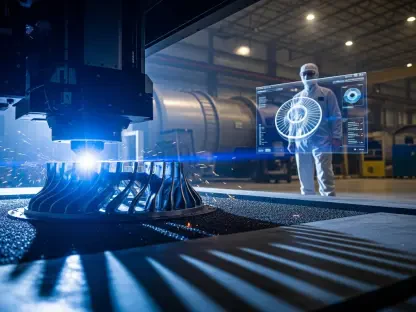In a significant stride towards innovative and sustainable resource management, Nord Precious Metals Mining Inc. has embarked on the ambitious deployment of pre-production development at the historic Castle High-Grade Silver Mine, situated in Ontario’s renowned Cobalt-Gowganda Camp. This initiative, marking the outset of a multi-phase project scheduled for seasonal silver-dominant production by 2026, involves the strategic mobilization of field crews along with heavy earth-moving equipment. This approach signifies a melding of economic aspirations with environmental responsibility. At the heart of this endeavor is the meticulous preparation for a cutting-edge gravity circuit designed to rehabilitate legacy tailings, thereby counteracting environmental degradation while also facilitating economic revitalization. The rich legacy of the Castle Mine as a historic silver producer sets a compelling stage for this contemporary initiative, as Nord seeks to redefine existing environmental burdens into profitable ventures.
Harnessing Legacy and Innovating for the Future
The development of this historic site encompasses crucial infrastructure improvements, including the enhancement of roads and the construction of pads at key tailings deposits, notably the Miller Creek tailings pad and the Castle West coarse-tailings pile. These preparations are vital for the ambitious plans laid out by Nord, as the company aims to leverage proven grades derived from extensive drilling and metallurgical assessments. These evaluations have underscored significant silver potential while also highlighting secondary elements such as cobalt, copper, and nickel, all of which are essential for modern technological advancements and the sustainable energy sector. This not only aligns Nord with current technological trends but also positions the company strategically within the market.
Nord’s Chief Executive Officer, Frank J. Basa, has been forthcoming in emphasizing the modular design of the company’s operations, which showcases the potential for substantial cash flow generation while simultaneously addressing environmental challenges. The company’s innovative low-carbon plant design is a standout feature: modular gravity modules delivered in pre-assembled ISO containers and situated on eco-friendly crushed-rock pads, bypassing conventional CO₂-intensive foundations. This novel approach enhances the sustainability quotient of the project, providing the flexibility to repurpose or entirely remove facilities post-resource extraction, underscoring Nord’s commitment to minimal environmental impact and comprehensive reclamation. This modularity extends the project’s reach and applicability, promising various avenues for future development and deployment.
Regulatory Support and Community Engagement
A critical facet of Nord’s progression involves navigating the regulatory landscape, with the company’s permitting process receiving significant encouragement from Ontario’s Ministry of Mines. The ministry’s proactive stance has led to an invitation for Nord to submit an 80-day Recovery Permit application in accordance with section 152.1 of the Mining Act. This streamlined permitting framework serves as a reinforcement of governmental support for environmentally conscious mining operations in the area. Filing of this permit is scheduled to commence after July 1, paving the way for on-site wet commissioning anticipated in the third quarter, with full-scale seasonal processing slated to begin by July 2026. These timelines, while contingent on weather conditions, mark a significant milestone in the project’s development.
The project, however, extends beyond economic gain, intricately woven with Environmental, Social, and Governance (ESG) impacts, alongside a deduced emphasis on partnerships with First Nations communities. By utilizing benign materials to backfill legacy tailings within underground stopes, Nord not only diminishes environmental hazards but also endorses long-term sustainability. This initiative further promises to create training roles and environmental monitoring jobs in collaboration with Indigenous communities, ensuring that the project’s benefits are inclusive and far-reaching. This strategic focus on community involvement underscores Nord’s commitment to harmonious and mutually beneficial operations.
Addressing Challenges and Embracing Technology
Nord’s strategy is underpinned by a robust and strategic framework, refined through a consistent track record of sustainable mining practices. Nevertheless, the project is not exempt from risks, primarily stemming from the experimental nature of processing tailings without a concurrent feasibility study. The lack of such a preliminary study inherently increases the potential for unforeseen technical or economic challenges. Though current projections remain optimistic, the variability in metal grades, processing methodologies, and cost uncertainties are palpable risks that may impact overall project profitability. Staying ahead of these challenges will require continued vigilance and adaptability from Nord’s technical teams.
Technical processes are buoyed by Nord’s reliance on advanced metallurgical expertise facilitated at their Temiskaming Testing Labs (TTL) facility, the district’s sole permitted analytical hub. This infrastructure is pivotal, acting as the focal processing center for both new mining material and legacy tailings, with a keen concentration on sustainability reflected in substantial investments in gravity concentration equipment. By focusing on high-grade silver recovery, the company is well-positioned to capitalize on the synergistic value of extracting other critical materials such as cobalt, nickel, and other battery metals. Moreover, Nord’s exclusive Re-2Ox hydrometallurgical process enhances operational capabilities, enabling the production of technical-grade cobalt sulfate and nickel-manganese-cobalt (NMC) formulations, which remain vital for contemporary battery technologies.
Future Prospects and Strategic Vision
The development of this historic site involves vital infrastructure enhancements, including upgrading roads and constructing pads at key tailings deposits such as the Miller Creek tailings pad and the Castle West coarse tailings pile. These efforts are in line with Nord’s ambitious plans to optimize proven grades from extensive drilling and metallurgical evaluations. These studies have unveiled notable silver potential and secondary elements like cobalt, copper, and nickel, crucial for modern technology and sustainable energy sectors. This enables Nord to align with contemporary technological trends and positions the company strategically in the market landscape.
Frank J. Basa, Nord’s CEO, has highlighted the modular design of the company’s operations, which is key to generating substantial cash flow while addressing environmental concerns. The company’s innovative low-carbon plant design features modular gravity modules shipped in pre-assembled ISO containers and set on eco-friendly crushed rock pads, avoiding conventional CO₂-intensive foundations. This approach heightens sustainability, offering flexibility to repurpose or remove facilities post-extraction, underscoring Nord’s commitment to minimal environmental impact and future adaptability.









